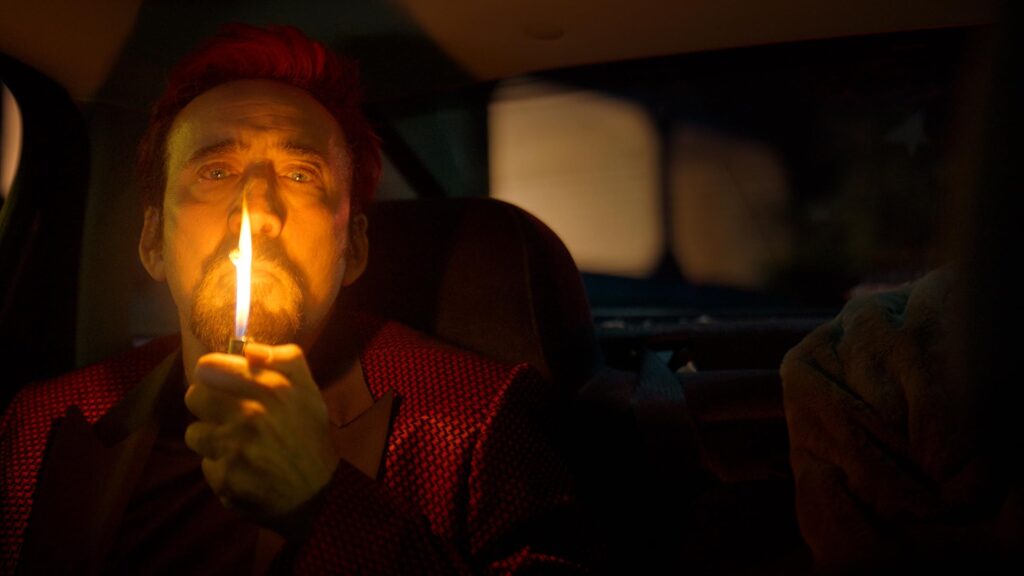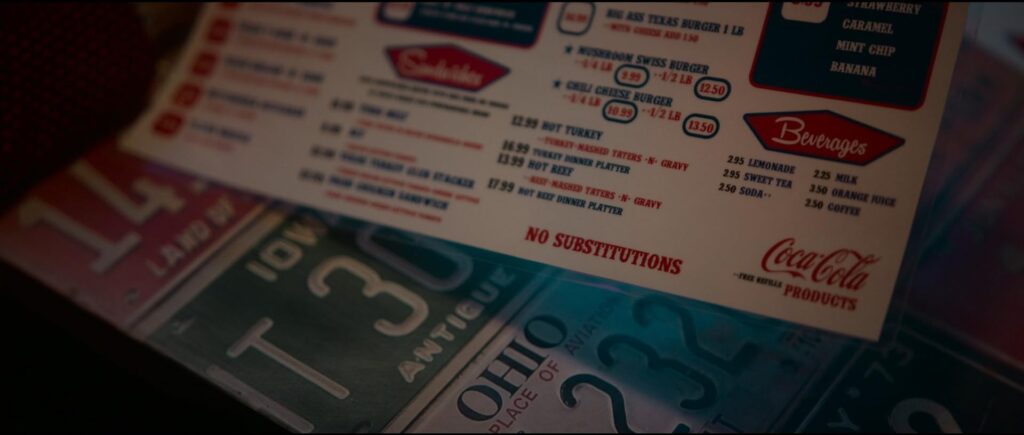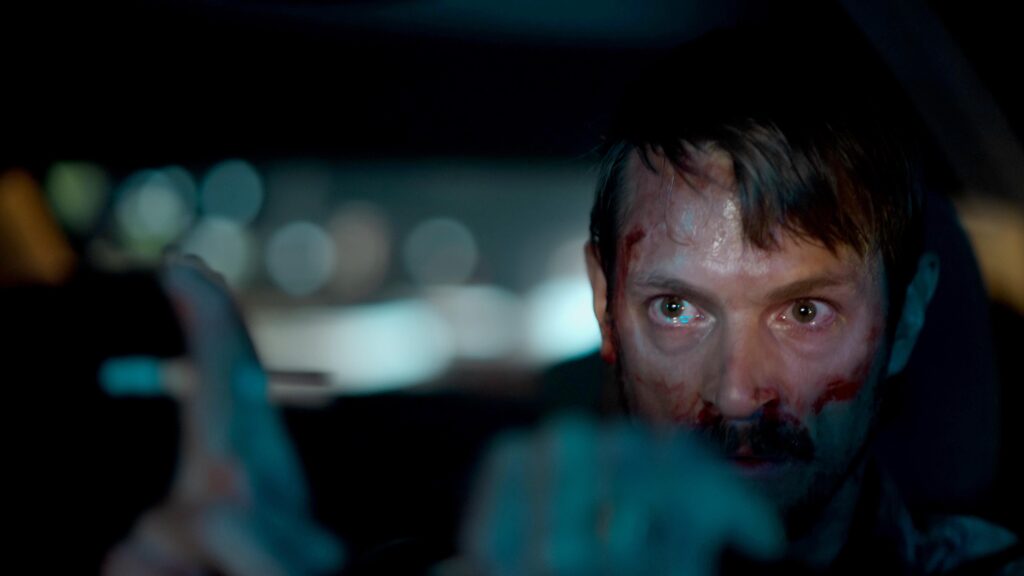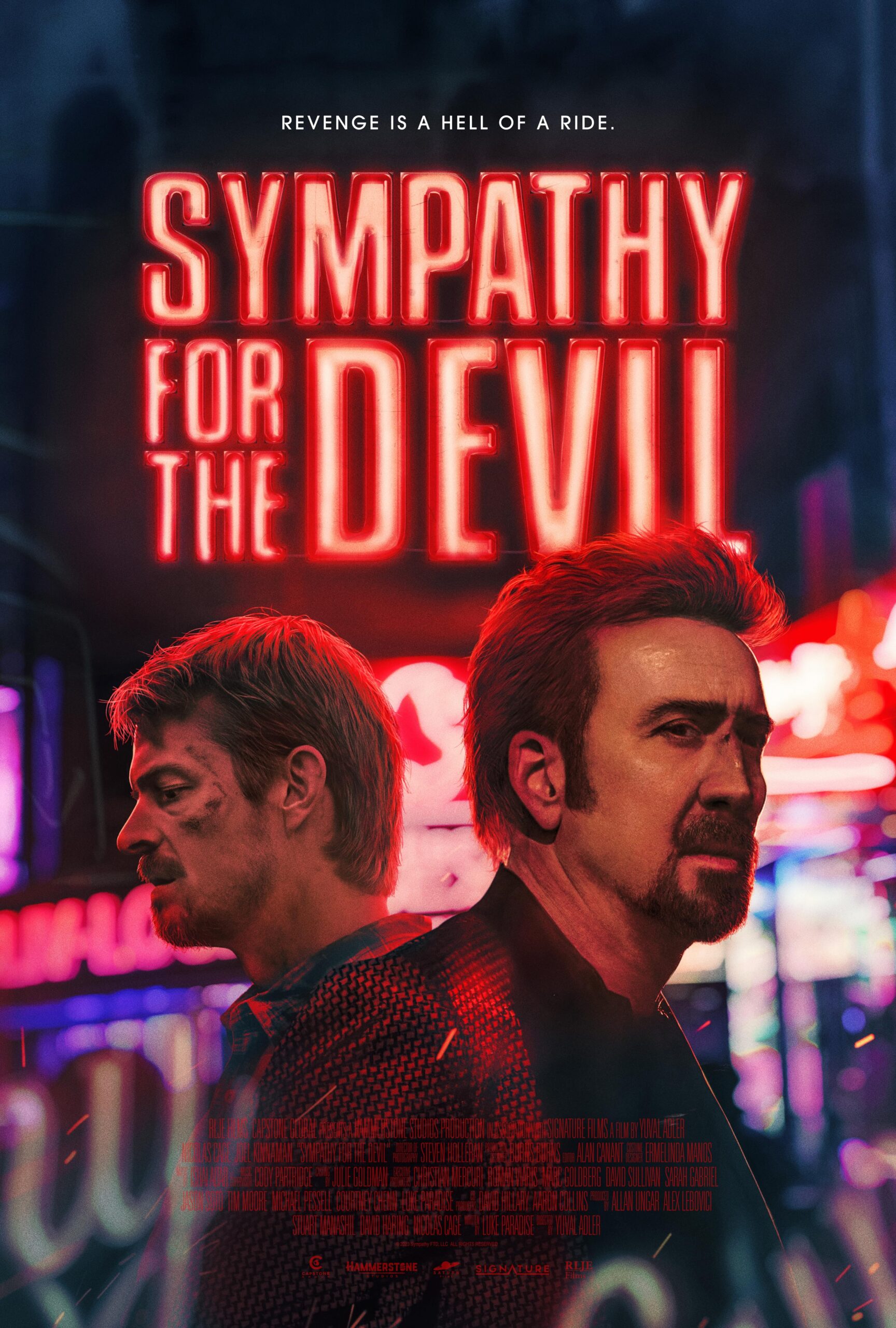Table of Contents
Plot
Welcome To Sympathy for the Devil (2023) Movie review. Sympathy for the Devil (2023) is a neo-noir thriller film directed by David Fincher and starring Joel Kinnaman and Nicolas Cage. The film follows David Chamberlain (Kinnaman), a seemingly ordinary blue-collar worker who is forced to drive a mysterious passenger at gunpoint, The Passenger (Cage). As David drives through the night, The Passenger begins to unravel his dark past, revealing that David is not who he seems.
The film opens with David rushing to the hospital to be with his wife Maggie, who is about to give birth to their third child. As he is driving, he is pulled over by a police officer who recognizes him as a former criminal. David manages to escape, but not before the officer shoots at him.
David flees into a parking garage, where he is cornered by The Passenger. The Passenger forces David to drive him to an abandoned warehouse. As they drive, The Passenger begins to tell David about his past. He reveals that he is a former bookkeeper for the Boston mob, and that he was responsible for David’s arrest.
The Passenger also tells David that he knows about David’s dark past. He claims that David was a hitman for the mob, and that he murdered The Passenger’s wife and daughter. David denies these accusations, but The Passenger doesn’t believe him.

When they arrive at the warehouse, The Passenger ties David up and begins to torture him. He wants David to confess to his crimes, but David refuses. The Passenger then leaves David alone in the warehouse, promising to return.
David manages to escape from the warehouse and flees into the desert. He is pursued by The Passenger, but he manages to lose him. David then makes his way to a nearby motel, where he tries to contact his wife.
David realizes that he needs to find a way to clear his name and stop The Passenger. He decides to go back to Boston and confront his past.
When David arrives in Boston, he meets with an old friend, Jimmy Sullivan. Jimmy tells David that he knows about David’s dark past, but he believes that David has changed. Jimmy also tells David that he knows who The Passenger is.
Jimmy reveals that The Passenger’s real name is Jacob Sullivan. He was Jimmy’s brother, and he was a former member of the Boston mob. Jacob was killed by the mob after he went rogue. However, Jimmy believes that Jacob is still alive, and that he is now seeking revenge on David.
David and Jimmy decide to team up to stop Jacob. They track Jacob down to a warehouse, where they confront him. Jacob confesses to killing David’s family, but he claims that David had it coming.
David and Jimmy fight Jacob, and David eventually kills him. However, David is shot in the process.
David returns to the hospital to be with Maggie and their newborn child. He is still haunted by his past, but he is determined to start a new life.
Action Sequences
The action sequences in the movie “Sympathy for the Devil” are relatively short and sparse, but they are well-choreographed and executed. The film’s director, Yuval Adler, uses a variety of techniques to create suspense and excitement, including close-ups, quick cuts, and creative camera angles.
One of the most memorable action sequences in the film takes place early on, when the protagonist, Simon (Joel Kinnaman), is forced to drive his mysterious passenger, Roy (Nicolas Cage), across the country at gunpoint. Along the way, they are pursued by a team of assassins who are trying to kill Roy.

The sequence begins with Simon and Roy driving through a deserted desert landscape. Simon is tense and nervous, and he knows that he is in danger. Roy, on the other hand, is calm and collected. He tells Simon that he is a powerful man and that he has nothing to fear.
Suddenly, the assassins open fire on Simon’s car. Simon swerves to avoid the bullets, but the car is hit and begins to smoke. Simon and Roy duck for cover, and Simon tries to figure out a way to escape.
Simon sees a road up ahead and decides to take it. He drives the car down the road at high speed, with the assassins in hot pursuit. Simon knows that he has to lose them, or he and Roy will be killed.
Simon drives the car through a series of twists and turns, and the assassins have difficulty keeping up. Simon then sees a bridge ahead and decides to make a run for it. He drives the car onto the bridge and speeds towards the other side.
The assassins follow Simon onto the bridge, but they are unable to stop him. Simon drives the car off the bridge and into a river below. The assassins are forced to stop, and Simon and Roy escape.
Another notable action sequence in the film takes place towards the end, when Simon and Roy are attacked by a group of armed men in a warehouse. Simon and Roy are outnumbered, but they fight back bravely.
The sequence is fast-paced and brutal, and it features some impressive stunt work. Simon and Roy use a variety of weapons, including guns, knives, and even a crowbar. They are able to kill several of their attackers, but they are eventually overwhelmed.
Just when it seems like Simon and Roy are about to be killed, they are rescued by a mysterious woman named Annie (Caitriona Balfe). Annie helps Simon and Roy escape from the warehouse, and they flee into the night.
The action sequences in “Sympathy for the Devil” are not as elaborate or flashy as those in some other action movies. However, they are well-executed and suspenseful. The film’s director, Yuval Adler, uses a variety of techniques to create excitement and keep the audience engaged.
Overall, the action sequences in “Sympathy for the Devil” are a positive aspect of the film. They are well-choreographed and executed, and they help to create suspense and excitement. While they may not be as elaborate or flashy as those in some other action movies, they are still effective and enjoyable to watch.
Character Development
The character development in the movie Sympathy for the Devil is complex and nuanced. The film follows the story of David, a man who is about to become a father, but his life is turned upside down when he witnesses a murder. He is drawn into a dangerous world of crime and corruption, and he must confront his own darkness in order to survive.

David’s character development is central to the film. At the beginning of the film, he is a relatively ordinary man. He is married, has a good job, and is about to become a father. However, the events of the film force him to confront his own capacity for violence and evil.
One of the most significant moments in David’s character development occurs when he is forced to kill a man in self-defense. This experience has a profound impact on him, and it makes him realize that he is capable of much more than he thought possible.
As the film progresses, David becomes increasingly hardened and cynical. He begins to lose his moral compass, and he is willing to do whatever it takes to survive. However, he also begins to develop a sense of empathy for the people he meets, even those who are on the wrong side of the law.
In the end, David’s character arc is one of redemption. He realizes that he does not want to become a monster, and he chooses to fight for what is right, even though it means putting himself in danger.
Here is a more detailed look at the character development of some of the other key characters in the film:
The Passenger: The Passenger is a mysterious figure who helps David navigate the criminal underworld. He is initially presented as a cold and calculating individual, but we later learn that he has a hidden agenda. The Passenger’s character development is complex and ambiguous, and it is unclear whether he is ultimately a good or bad influence on David.
Kathryn Russell: Kathryn is the wife of the man who murders Lena, the woman who blackmailed David. She is initially presented as a victim, but it is later revealed that she is also capable of violence and manipulation. Kathryn’s character development is particularly interesting, as she is forced to confront her own darkness in order to protect herself and her family.
Helen Tozer: Helen is David’s pregnant wife. She is a kind and supportive person, and she helps David to stay grounded throughout the film. Helen’s character development is relatively minor, but she plays an important role in David’s redemption arc.
Overall, the character development in Sympathy for the Devil is complex and nuanced. The film explores the dark side of human nature, but it also offers a message of hope and redemption.
In addition to the above, I would also like to add that the film’s title, Sympathy for the Devil, is a reference to the Rolling Stones song of the same name. The song is about the duality of human nature, and it explores the dark side of our capacity for good and evil.
The film’s title suggests that the film will be sympathetic to the devil, or to the dark side of human nature. However, the film ultimately suggests that there is still hope for redemption, even for those who have committed terrible acts.
Themes
The movie Sympathy for the Devil explores a number of themes, including:
Revenge: The film’s central conflict is driven by the protagonist, The Passenger (Nicolas Cage), seeking revenge against a man he believes has wronged him. The Passenger’s thirst for vengeance leads him to hijack the car of David (Joel Kinnaman), a seemingly ordinary man who is on his way to the hospital to be with his wife for the birth of their child.
Good and evil: The film also explores the complex nature of good and evil. The Passenger is clearly a villain, but he is also charismatic and intelligent. David, on the other hand, is meant to be a sympathetic protagonist, but he is also capable of violence and deceit.

The film suggests that good and evil are not always black and white, and that even the most ordinary people can be capable of great acts of darkness.
The corrupting influence of violence: The film shows how violence can corrupt even the most well-intentioned people. As David is forced to participate in The Passenger’s increasingly violent rampage, he begins to lose his grip on his own morality.
The importance of second chances: The film raises the question of whether or not people who have done terrible things deserve a second chance. The Passenger believes that he is entitled to revenge, and that he is justified in his actions. David, on the other hand, comes to believe that The Passenger isredeemableand deserves to be given a second chance.
The film’s title, Sympathy for the Devil, is taken from the song of the same name by The Rolling Stones. The song is a complex and ambiguous meditation on good and evil, and it suggests that even the Devil himself is worthy of some sympathy. The film’s title suggests that the film is not simply a condemnation of violence and revenge, but that it also seeks to understand the motivations of those who commit such acts.
In addition to the themes listed above, the film also explores other topics such as the nature of family, the importance of community, and the dangers of isolation.
Overall, Sympathy for the Devil is a complex and thought-provoking film that explores a number of important themes. It is a film that is likely to stay with viewers long after they have seen it.
Direction
Adler’s direction of Sympathy for the Devil is characterized by its use of tension and suspense, as well as its exploration of the dark side of human nature. The film is set almost entirely in a car, and Adler uses the confined space to create a sense of claustrophobia and dread. He also uses tracking shots and close-ups to keep the viewer on edge, and he builds suspense through the use of silence and sound effects.

One of the most effective aspects of Adler’s direction is his use of Cage and Kinnaman’s performances. Cage is perfectly cast as the unhinged Passenger, and he delivers a memorable performance that is both terrifying and sympathetic. Kinnaman is also excellent as The Driver, a man who is slowly being drawn into the Passenger’s dark world.
Adler also does a good job of developing the film’s themes. Sympathy for the Devil is a film about good and evil, and Adler explores the ways in which people can be corrupted by power and desire. He also examines the nature of revenge and the consequences of violence.
Overall, Adler’s direction of Sympathy for the Devil is strong. He creates a tense and suspenseful atmosphere, and he delivers a powerful and thought-provoking film.
Here are some specific examples of Adler’s direction in the film:
In one scene, The Passenger forces The Driver to drive through a deserted desert landscape. Adler uses long tracking shots to emphasize the isolation and vulnerability of The Driver.
In another scene, The Passenger tells The Driver a story about a man who was slowly driven insane by his own guilt. Adler uses close-ups of Cage’s face to convey the Passenger’s increasing madness.
In the film’s climax, The Passenger and The Driver engage in a physical altercation. Adler uses rapid editing and close-ups to create a sense of chaos and violence.
Adler’s direction is not without its flaws. Some critics have argued that the film is too slow-paced and that the ending is unsatisfying. However, overall, Adler’s direction is effective and helps to create a tense and suspenseful thriller.
Cinematography
The cinematography of Sympathy for the Devil (2023) is a key element of the film’s overall atmosphere and tone. Cinematographer Steven Holleran uses a variety of techniques to create a sense of unease and suspense, while also highlighting the beauty and danger of Las Vegas.
One of the most striking aspects of the cinematography is Holleran’s use of shadows. Shadows are often used to create a sense of mystery and danger, and Holleran uses them to great effect in Sympathy for the Devil. For example, in one scene, the protagonist, David, is driving through the desert at night. The headlights of his car illuminate the road ahead, but the surrounding landscape is cast in darkness. This creates a sense of isolation and vulnerability for David.

Another key element of Holleran’s cinematography is his use of color. The film is often bathed in a warm, neon glow, which gives it a distinctly Las Vegas feel. However, Holleran also uses color to create a sense of unease and danger. For example, in one scene, David is being chased by the police. The police cars are flashing their lights, and the scene is bathed in a harsh, white light.
Holleran also uses camera movement to great effect in Sympathy for the Devil. He often uses handheld camerawork to create a sense of immediacy and realism. For example, in one scene, David is running through a casino. The camera is handheld, and the viewer feels like they are right there with David, experiencing the danger and excitement of the situation.
Overall, the cinematography of Sympathy for the Devil is excellent. Holleran uses a variety of techniques to create a sense of unease, suspense, and danger. He also uses color and camera movement to create a visually stunning film.
Here are some specific examples of Holleran’s cinematography in the film:
In one scene, David is driving through the desert at night. The headlights of his car illuminate the road ahead, but the surrounding landscape is cast in darkness. Holleran uses long takes and wide shots to create a sense of isolation and vulnerability for David.
In another scene, David is being chased by the police through the streets of Las Vegas. Holleran uses handheld camerawork and close-ups to create a sense of immediacy and danger.
In a third scene, David is meeting with a mysterious stranger in a hotel room. Holleran uses low-key lighting and close-ups to create a sense of tension and suspense.
Holleran’s cinematography is essential to the success of Sympathy for the Devil. He helps to create a film that is both visually stunning and psychologically unsettling.
Music
The music of the 2023 film Sympathy for the Devil is composed by Ishai Adar, and features a mix of original score and licensed tracks. The original score is atmospheric and suspenseful, using a variety of instruments and textures to create a sense of tension and unease. The licensed tracks are all classic rock songs from the 1960s and 1970s, and they help to set the tone for the film’s dark and twisted story.
One of the most notable aspects of the film’s music is its use of the Rolling Stones song “Sympathy for the Devil.” The song is used in several different scenes throughout the film, and it serves as a kind of thematic leitmotif. The song’s lyrics about the devil’s influence on human affairs are perfectly suited to the film’s story about a man who is forced to confront his own dark side.

Other licensed tracks that feature prominently in the film’s soundtrack include:
“The Old Man’s Back Again” by Scott Walker
“Without Your Love” by Jimmy Radcliffe
“1969” by Jimmy Radcliffe
“Turn Around” by Jimmy Radcliffe
“Save Me” by Jimmy Radcliffe
“As Late as the Hour May Be” by Jimmy Radcliffe
These songs are all from the same era as the Rolling Stones’ “Sympathy for the Devil,” and they help to create a sense of nostalgia and atmosphere for the film. They also evoke the themes of darkness, temptation, and redemption that are central to the film’s story.
Overall, the music of Sympathy for the Devil is an essential part of the film’s experience. It helps to create a sense of tension and suspense, and it also provides a soundtrack for the film’s dark and twisted story.
In addition to the above, it is worth noting that the music of Sympathy for the Devil has been praised by critics for its effectiveness in creating a sense of atmosphere and suspense. For example, David Ehrlich of IndieWire wrote that the film’s “music is perfectly calibrated to heighten the tension and unease.” Similarly, Nick Allen of RogerEbert.com said that the film’s “music is a major asset, creating a sense of dread and unease that permeates the entire film.”
Overall, the music of Sympathy for the Devil is an important part of what makes the film so effective. It is well-composed, well-chosen, and well-used. It helps to create a sense of atmosphere and suspense, and it also provides a soundtrack for the film’s dark and twisted story.
Personal Opinion
I really enjoyed the movie “Sympathy for the Devil”. It was a well-made and thought-provoking film that explored the complex nature of evil. The performances were all excellent, and the story was both suspenseful and disturbing.
One of the things I liked most about the film was its ambiguity. There was no easy answer to the question of whether the protagonist was a good person or a bad person. He was clearly capable of great evil, but he also had moments of kindness and compassion. This made him a very complex and compelling character.

The film also did a good job of exploring the theme of free will. The protagonist was clearly a product of his environment, but he also had the ability to make choices. He could have chosen to be a good person, but he chose to be evil. This made me think about the nature of good and evil, and the choices that we all make in our lives.
Overall, I thought “Sympathy for the Devil” was a very well-made and thought-provoking film. It was a film that stayed with me long after I had seen it. I would definitely recommend it to anyone who is interested in films that explore the dark side of human nature.
FAQs
Is the movie “Sympathy for the Devil” related to the Rolling Stones song of the same name?
No, the movie is not directly related to the Rolling Stones song. However, the title of the movie is a reference to the song, and the movie explores some of the same themes of temptation, evil, and redemption.
What is the meaning of the movie’s title, “Sympathy for the Devil”?
The title of the movie is a reference to the Rolling Stones song, which explores the idea of the devil as a temptation. The movie also explores the idea of whether or not it is possible to have sympathy for someone who has done terrible things.
What are some of the critical reviews of the movie “Sympathy for the Devil”?
Some critics have praised the film’s performances, action sequences, and dark tone. Others have criticized the film’s uneven pacing, underdeveloped characters, and lack of originality.
Check out the latest Action Movies.
